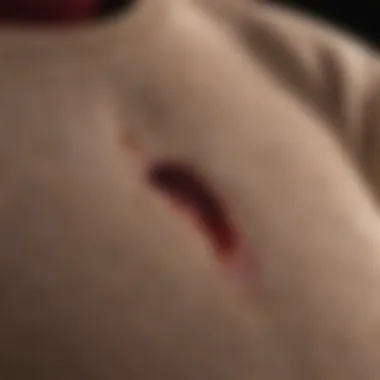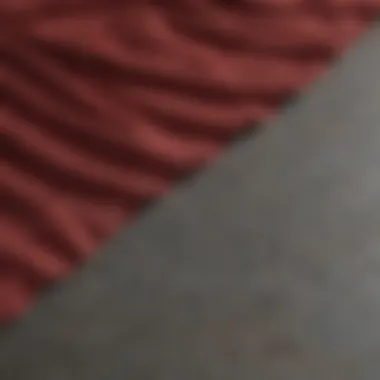Effective Strategies for Removing Wine Stains from Sweaters


Intro
Wine stains pose a significant challenge, particularly when they occur on cherished garments such as sweaters. Often, these stains are not just unsightly but can also seem nearly impossible to remove. Understanding the science behind stains and the best methods to eliminate them is essential for anyone who enjoys wine or frequently hosts gatherings. This guide aims to provide effective strategies tailored to various fabric types, ensuring that you can confidently address these stains.
Understanding Wine Stains
Wine contains pigments and tannins that can penetrate fabric fibers, making them difficult to extract. The quicker the stain is addressed, the higher the chances of complete removal. Delaying treatment allows the wine to set, increasing the difficulty of the cleaning process. Different fabrics react differently to various treatments, requiring a tailored approach.
The sooner you act on a wine stain, the better your chances are of successfully removing it.
Immediate Response Strategies
Acting quickly is crucial when dealing with wine stains. The following techniques can help minimize their impact:
- Blot, Don’t Rub: Gently blot the stain with a clean cloth or paper towel to absorb excess wine. Rubbing can spread the stain and push it deeper into the fibers.
- Use Salt or Baking Soda: After blotting, sprinkle salt or baking soda on the area. These substances can absorb some of the liquid and help lift the stain.
- Cold Water Rinse: If possible, rinse the stained area with cold water. This can prevent the wine from setting further into the garment.
Treatment Methods for Different Fabrics
Different fabrics require distinct cleaning methods. Here’s a breakdown:
Cotton and Linen Sweaters
These fabrics can withstand more aggressive treatment. Follow these steps:
- Apply White Vinegar: Mix equal parts of white vinegar and water, then apply it directly to the stain.
- Launder as Usual: After treating, wash the sweater in the washing machine using the hottest water safe for the fabric.
Wool and Cashmere Sweaters
Delicate fibers need careful handling:
- Use a Wool Wash: Apply a specialized wool wash solution to the stain, using your fingers to gently massage it in.
- Rinse Carefully: Rinse with cool water to remove the wash and any remaining wine.
Synthetic Fabrics
Synthetic fibers can hold stains more stubbornly:
- Stain Remover Spray: Apply a pre-treatment stain remover. Let it sit for about 5-10 minutes.
- Machine Wash: Wash in cold water on a delicate cycle.
Preventive Measures
Taking steps to prevent wine stains can save time and effort in the long run. Here are a few suggestions:
- Choose Wine Carefully: Consider using white or lighter wines, which generally have less potential for staining.
- Utilize Spills Guards: Employ coasters or spill guards at your events to minimize the risk of accidents.
Closure
Wine stains on sweaters can seem daunting, but with the right knowledge and tools, they are manageable. By acting promptly and employing the correct methods according to fabric type, you can successfully address and perhaps, eliminate these stains. Always remember to test your cleaning method on a hidden area of the fabric first to ensure there is no adverse reaction.
Understanding Wine Stains
Understanding wine stains is crucial for anyone who wishes to maintain the integrity of their sweaters. Wine stains can be particularly unforgiving on fabrics, leading to permanent discoloration if not treated promptly and correctly. This section highlights the nature of wine stains, including their composition, effects on different materials, and their classification based on freshness. By grasping these foundational aspects, individuals are better equipped to implement effective removal strategies.
Chemical Composition of Wine
Wine consists mainly of water, sugars, acids, and phenolic compounds. The pigments responsible for the characteristic color of wine are mainly anthocyanins, which are found in the skins of red grapes. When spilled, these components infiltrate the fibers of clothing, making wine stains notoriously difficult to eliminate. Understanding this chemical composition aids in selecting appropriate cleaning methods that can target the specific elements causing the stain.


Impact of Wine Stains on Fabrics
Wine stains pose varying levels of risk depending on the fabric type. For instance, natural fibers like wool and cotton absorb liquids more readily compared to synthetic fabrics like polyester. This can lead to deeper penetration of the wine, making removal challenging. Moreover, the acidity of wine may also impact the dye of certain fabrics, resulting in discoloration that is permanent. Recognizing how wine interacts with different materials helps in devising an effective cleaning approach that minimizes damage.
Stain Classification: Fresh vs. Set
Stains can generally be classified into two categories: fresh and set. Fresh stains are those that have just occurred, and they require immediate attention. Acting quickly on fresh stains often yields better results, as the pigments have not yet bonded with the fibers. In contrast, set stains have already dried and may have chemically bonded to the fabric. These require more intensive treatment methods, such as soaking or using specialized cleaners. Understanding the difference between these two classifications allows individuals to assess their situation clearly and choose the most suitable course of action for effective stain removal.
Immediate Actions for Fresh Stains
Addressing wine stains promptly is crucial in the battle to protect your beloved sweaters. Addressing the stain while it is still fresh significantly increases your chances of complete removal. The chemical properties of wine mean that they can bond with the fabric fibers over time, making stains difficult to eliminate. By understanding and implementing effective immediate actions, you can mitigate damage and prevent permanent discoloration or staining. This section details steps that are part of an effective stain removal strategy, focusing on three essential methods: blotting, using cold water, and applying absorbent materials like salt or baking soda.
Blotting the Stain
Blotting is the first and perhaps the most important step when dealing with fresh wine stains. It involves gently pressing a clean cloth or paper towel against the stain to soak up as much liquid as possible. The goal is to absorb the excess wine without rubbing it further into the fibers.
- Use a clean white cloth or paper towel to avoid transferring dye onto the fabric.
- Start at the outer edges of the stain and work inward. This method helps prevent the stain from spreading.
- Avoid scrubbing, which can damage the fabric and increase the likelihood of a permanent stain.
By removing excess wine, you are decreasing the concentration of pigments that can set into the fabric.
Using Cold Water
Cold water plays a vital role in the initial stages of stain removal. After blotting, rinsing the affected area with cold water can help dilute the wine's pigments, preventing them from settling into the fibers.
- Rinse the fabric from the back side to push the stain out rather than deeper into the material.
- Always use cold water, as hot water can cause the stain to set.
- Continue rinsing for several minutes to ensure that you are diluting the wine effectively.
This method helps in reducing the stain's intensity before applying any cleaning solutions, thus maximizing removal effectiveness.
Applying Salt or Baking Soda
After blotting and rinsing, applying a generous amount of salt or baking soda can further assist in absorbing residual wine and moisture.
- Salt can draw out liquid due to its hygroscopic properties. Apply it to the wet stain and allow it to sit for about five to ten minutes.
- Baking soda also acts as a mild abrasive and can absorb the stain similarly. Mix baking soda with a small amount of water to create a paste and apply it to the stain.
- After the application period, gently blot the fabric again to remove the salt or baking soda.
Using these absorbent materials increases your chances of effective stain removal prior to employing further treatment methods.
"Immediate action is essential when dealing with wine stains; it is much easier to manage a fresh stain than one that has set."
Understanding and utilizing these immediate actions sets the stage for the subsequent steps in stain removal. Implementing these methods as soon as a spill occurs is your best strategy for preserving the integrity of your sweaters.
Stain Removal Techniques
Effective stain removal is critical when dealing with wine stains on sweaters. When wine spills occur, immediate action can prevent permanent damage. Different methods of stain removal exist, each suited for a specific type of stain and fabric. Understanding these techniques allows for a more informed approach to tackling wine stains, increasing the chances of successful removal. The considerations include the type of fabric, the age of the stain, and the availability of cleaning solutions.
Commercial Stain Removers
Commercial stain removers are specially formulated products designed to tackle tough stains, including wine. They often contain enzymes that break down the organic compounds in the stain, making them effective against a variety of stains. The key characteristic of these products is their targeted formulations, which are developed for particular stain types. Using a commercial product saves time and effort since they usually require simple application steps. However, it is essential to read the labels carefully because some may contain harsh chemicals that could damage delicate fabrics like cashmere or silk. Always test on an inconspicuous area before full application.
Homemade Solutions
Many homeowners prefer homemade solutions for stain removal due to their accessibility and cost-effectiveness. Here are three popular options:
Vinegar and Dish Soap
A simple solution of white vinegar and dish soap can be very effective against wine stains. The acidity of vinegar helps break down the stain while the dish soap lifts it away. This method is notable for its non-toxicity, making it a safe choice for many fabrics.
The unique aspect of using vinegar and dish soap is their ability to blend seamlessly, creating a potent cleaning agent. However, vinegar's strong smell can be a drawback for some users. It’s advisable to rinse thoroughly to remove any residual odor after cleaning.
Hydrogen Peroxide and Dish Soap


Hydrogen peroxide combined with dish soap is another powerful stain fighter. This mixture acts as a bleaching agent and can be effective on white or light-colored fabrics. The primary benefit of this solution is its ability to lift stains that have set in over time. The unique feature of hydrogen peroxide is its disinfecting properties, which may also help eliminate odor. Caution is warranted, however, as this solution can discolor darker fabrics. Always test on a small corner of the sweater to ensure color stability before application.
Lemon Juice and Baking Soda
This combination is naturally acidic and works well to lift wine stains. Lemon juice acts similarly to vinegar, while baking soda provides a gentle abrasive action that can help scrub the stain out. The blend is also popular because it leaves a fresh scent. The unique characteristic of using lemon juice and baking soda is their ability to brighten colors while cleaning. Yet, the abrasive action of baking soda might not be suitable for delicate fabrics. It’s important to apply this method gently to avoid damaging the material.
Washing the Sweater
After treating the stain, it’s important to wash the sweater properly. Follow the care instructions on the label and use a mild detergent. Washing at the correct temperature is essential to avoid shrinking the fabric. Check the stain after washing before drying; if it remains, do not put the sweater in the dryer, as high heat can set the stain further. Repeat the stain removal process as necessary to achieve the best results.
Removing Set Stains
Addressing set wine stains is crucial because they pose a greater challenge than fresh stains. Once the wine has dried, its pigments bond more tightly to the fabric’s fibers, making it harder to remove. Ignoring these stains can lead to permanent damage or discoloration of the sweater, and the longer they sit, the more complicated the removal process becomes. Therefore, knowing how to effectively target these set stains is imperative for preserving the integrity of your favorite garments.
Pre-treating with Enzymatic Cleaners
Enzymatic cleaners are specifically formulated to break down organic stains, including those from wine. The enzymes in these cleaners work effectively on the proteins and pigments in the wine, allowing for easier removal from the fabric. Before applying the cleaner, you should read the product instructions carefully. Apply a small amount directly on the stain and let it sit for the recommended time, generally around 10-15 minutes. Make sure to test the cleaner on an inconspicuous area of the fabric first, to avoid any unwanted reactions.
Soaking the Fabric
Soaking the stained sweater can significantly enhance the stain removal process. When dealing with set wine stains, immersion in a suitable cleaning solution can loosen the stain from the fibers. Fill a basin or sink with cold water and add a gentle detergent or a specialized stain removal solution. Submerge the entire sweater and allow it to soak for at least 30 minutes. This helps in adequately loosening the stain while also preparing the fabric for more thorough cleaning afterward.
Re-washing Techniques
After soaking, the next step is to re-wash the sweater properly. Gently wring out the fabric to remove excess water, but do not twist it too hard as this can distort its shape. When re-washing, use a mild detergent and set your washing machine to a gentle cycle. You should avoid using hot water, as it may set the stain further. If the stain persists after washing, refrain from drying the sweater in a dryer. Instead, air dry it to prevent the heat from permanently binding the stain to the fabric. Repeat the soaking and washing process as needed, until the stain is no longer visible.
It's important to note that some stains may require multiple treatments for complete removal, so patience is key when addressing set wine stains.
With these methods—pre-treating, soaking, and re-washing—you will give yourself the best chance at erasing those stubborn wine marks from your sweaters.
Considerations by Fabric Type
When it comes to removing wine stains from sweaters, the type of fabric plays a crucial role in determining both the approach and effectiveness of the treatment. Different materials respond uniquely to various cleaning methods. Therefore, understanding the fabric type is essential not only for successful stain removal but also for maintaining the integrity and appearance of the garment.
Using inappropriate techniques can further damage delicate fibers or set the stain deeper. Key considerations include the durability of the fabric, its absorbency, and how it interacts with cleaning agents. This section provides insight into how to approach stain removal based on the fabric's characteristics, enhancing both effectiveness and care in the cleaning process.
Natural Fibers: Wool and Cotton
Natural fibers such as wool and cotton have distinct properties that affect their susceptibility to stains and their response to cleaning methods. Wool, known for its softness and warmth, is absorbent but can be sensitive to heat and harsh chemicals. Cotton is also absorbent and generally more durable but can still suffer from irreversible damage if treated improperly.
When dealing with wine stains on these fabrics, the first step is to act quickly and avoid rubbing, which can spread the stain or embed it further. Blotting gently with a clean cloth can help absorb excess wine. Following this with a suitable stain remover can prevent the stain from setting.
For wool sweaters, consider using a mild detergent with a low pH. You can also create a waters solution with vinegar, as it can help break down the stain without harming the fibers. For cotton, using baking soda or salt for immediate absorption can be effective as well. Always check the care label before selecting products.
Synthetic Fabrics: Polyester and Acrylic
Synthetic fabrics, such as polyester and acrylic, tend to be more resilient compared to natural fibers. These materials are generally less absorbent, which can work to an advantage when treating stains. However, they can also retain stains if not cleaned properly.
To remove wine stains from synthetic fibers, begin with a gentle blotting action to soak up the wine. Then, apply a pre-treatment stain remover specifically designed for synthetic fabrics. These products are formulated to break down stains effectively without damaging the fabric's texture or color.
Machine washing on a gentle cycle after the pretreatment is often sufficient to eliminate any remaining stains. However, ensure the washing temperature aligns with the garment's care label, as excessive heat can cause synthetic fibers to warp.
Delicate Fabrics: Silk and Cashmere
Silk and cashmere are luxurious materials that require a high level of care. Their delicate nature makes them vulnerable to damage from harsh chemicals, extreme temperatures, and vigorous scrubbing. For these reasons, addressing wine stains on such fabrics needs to be executed with a gentle touch.


If a wine stain occurs on silk or cashmere, promptly blot the stained area using a soft cloth or paper towel to absorb excess liquid. Avoid rubbing, as this can damage the fibers. A suitable approach is to use a mixture of cool water and a drop of gentle detergent designed for delicate fabrics. Dabbing the stain lightly with this solution can help lift the stain without harming the material.
For any lingering stains, it’s often best to seek professional cleaning services, as they have specialized treatments for delicate fibers that most homeowners might not be equipped to handle.
Understanding the type of fabric is crucial for effective stain removal and maintaining garment quality.
In summary, each fabric type demands specific strategies to handle wine stains effectively. By recognizing the unique properties and care techniques for wool, cotton, synthetic fibers, silk, and cashmere, homeowners can take informed steps to preserve their favorite sweaters while addressing unsightly stains.
Preventing Future Stains
Preventive measures play a crucial role in maintaining the integrity of sweaters, particularly regarding wine stains. Wine can be enjoyable, but it is also a potential source of frustration when spills occur. Effective strategies for prevention not only save time and effort but also protect cherished garments.
Using Stain-Repellent Sprays
Stain-repellent sprays are an excellent first line of defense against potential stains. These products create a protective barrier that repels liquids, preventing them from soaking into the fabric. When selecting a spray, look for options specifically designed for textiles, such as the products from Scotchgard or Nikwax. Follow the manufacturer's instructions carefully to achieve the best results. Reapplication may be necessary after several washes or after wearing the sweater for extended periods.
Mindful Wine Consumption
Being mindful of how and where you consume wine can greatly affect the likelihood of stains. Consider your surroundings and the type of wine you are drinking. Red wine is notorious for its staining properties, so if you know you are likely to spill, consider using a darker-colored sweater or one that is easy to clean. Moreover, think about where you are sitting. Avoid positions that could lead to wine spills, such as leaning over or reaching across a table.
Caring for Your Sweaters
Proper care and maintenance of sweaters can significantly reduce the chances of wine stains and damage. Regular washing according to the care label can help maintain the fabric's integrity. This includes gentle washing cycles for delicate materials and using appropriate detergents. Moreover, storing sweaters correctly—such as folding rather than hanging—can prevent fabric stretch and distortions that may make them more susceptible to stains. Always ensure to check your sweater for any stains before putting it away, as prompt attention can often prevent permanent damage.
"An ounce of prevention is worth a pound of cure." This old adage rings especially true in the context of fabric care.
By adopting these preventive measures, one can significantly lower the chances of encountering stubborn wine stains in the first place, preserving the beauty and longevity of cherished sweaters.
Assessing the Effectiveness of Treatment
Assessing the effectiveness of treatment for wine stains is a crucial step in the stain removal process. After spending time and effort to clean the fabric, it is essential to ensure the stain has been successfully removed. This not only prevents lingering marks but also helps maintain the integrity and look of your sweater. The consequences of not assessing the treatment can be more serious than merely preventing cosmetic damage; it can also lead to fabric degradation over time if stains are not fully treated. Therefore, a systematic approach is beneficial.
Inspecting the Fabric Post-Cleaning
After any cleaning method, the first action should be to inspect the fabric. This involves checking both the stained area and the surrounding fabric. Look for any discoloration, and ensure that there are no remaining traces of the initial wine stain. If the stain is still visible, it might indicate that the cleaning method was ineffective or that the stain has set.
Consider the following steps during your inspection:
- Visual Examination: Take a close look at the stained area, ensuring there are no dark spots or discoloration.
- Texture Test: Run your fingers over the area. An uneven texture can indicate leftover residue or damage from the cleaning process.
- Smell Test: Sometimes, even if there is no visible stain, residual odors might linger. If a grape scent is still present, further treatment may be necessary.
If, after inspection, the stain persists, remember that some fabrics might require additional treatments such as enzyme cleaners or further soaking.
When to Seek Professional Help
At times, even the most thorough home treatments can fall short. If the inspection shows that the stain is still prominent, or if the fabric starts to show signs of damage, seeking professional help may be the best course of action.
Consider the following circumstances when deciding to consult a professional cleaner:
- Persistent Stains: Stains that resist multiple home treatment attempts may require specialized products and techniques.
- Delicate Fabrics: Fabrics like silk or cashmere are susceptible to damage from household cleaning agents. Professional cleaners know how to treat these materials safely.
- Value of the Garment: If the sweater is of significant monetary or sentimental value, it may be worth the investment to ensure it is treated properly.
In summary, assessing the effectiveness of treatment is essential for maintaining the longevity of your fabric. A careful inspection is the first step, and do not hesitate to enlist professional assistance when needed. Addressing stains effectively preserves not only the physical appearance of your sweaters but also enhances your overall garment care practices.
Ending
Removing wine stains from sweaters is more than just a tedious chore; it is essential for maintaining the quality and appearance of your garments. As we discussed, wine stains can set in quickly and vary greatly depending on various factors such as the type of wine and the fabric composition. Understanding these elements helps in developing a focused strategy for stain removal.
The article highlights effective steps from immediate responses to long-term prevention. Immediate actions, such as blotting and using cold water, are crucial. They can make the difference between a minor incident and a permanent mark. Furthermore, the discussion around different fabric types informs readers about the most suitable removal techniques, ensuring that delicate fabrics like silk are treated with care.
In assessing treatment effectiveness, the emphasis on inspecting the fabric post-cleaning provides valuable insights for homeowners and hosts alike. Knowing when professional help might be needed can save time and resources.
"The sooner you act, the better your chances of preserving your favorite sweater."
The benefits of being proactive against wine stains extend beyond the aesthetic. Maintaining your garments can ultimately save money and prolong the life cycle of your wardrobe. For anyone who regularly entertains or enjoys wine, these strategies will remain relevant. By embedding this knowledge into your routine, you can face wine spills with confidence, allowing you to focus on enjoyment rather than stress over potential stains.



